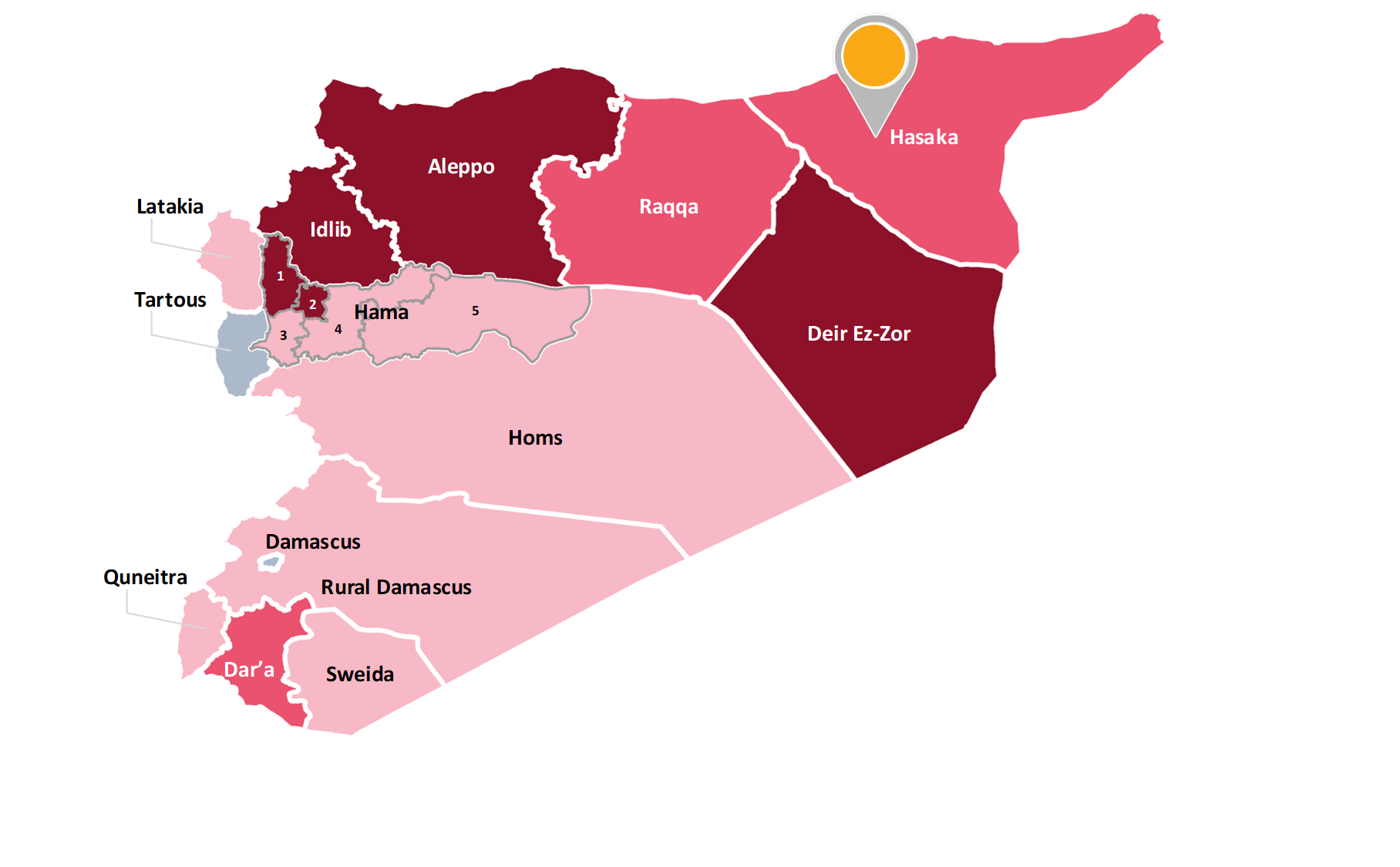[Main COI reference: Security 2020, 2.7]
The governorate of Hasaka is located in the northeast end of Syria, bordering Turkey to the north, Iraq to the east and the governorates of Raqqa and Deir Ez-Zor to the west and southwest respectively. The governorate is divided into four districts: Hasaka, Ras al-Ain, Qamishli and al-Malikiya. Population estimates for 2016 by the Syrian Central Bureau of Statistics indicated that Hasaka governorate had 1 621 000 inhabitants. Its capital city Hasaka is located in the middle of the governorate, on the intersection of the Khabour river and the road from al-Qamishli towards Deir Ez-Zor. The economy of Hasaka is based on agriculture, and some of Syria’s most important oil fields are situated in the governorate, which has drawn the interest of both internal and external actors.

In October 2019, Turkey launched its ‘Operation Peace Spring’ in order to oust the SDF/YPG from the Syrian side of the border and to establish a ‘safe zone’ for resettlement of Syrian refugees. Following the Turkish-led incursion into northeast Syria in October 2019, the SNA together with Turkish armed forces was reported to be in control of the so called ‘safe zone’ established between Tall Abyad (Raqqa governorate) and Ras al Ain (Hasaka governorate). On 14 October, the SDF concluded a military agreement with Damascus/Russia, authorising the return of some SAA troops to areas near the Turkish border earlier controlled by the SDF/YPG, in order to confront the SNA presence.
Since the end of October 2019, there has been a ceasefire over the area based on a memorandum of understanding between Russia and Turkey. However, this ceasefire has not been respected at all times and there have been combats between SAA units and Turkish forces and Turkish-backed SNA units.
The SDF/YPG is still the main force on the ground in northeast Syria. It retains control of vast territory, well-functioning military forces, oil resources and governance structures. The GoS maintained a limited security presence in northeast Syria, which included the cities of Qamishli and Hasaka in the governorate.
The Turkish incursion into northeast Syria led to an escalation of military violence, which greatly affected civilians in the region. The fighting following Turkey’s/SNA’s offensive in the area was marked by indiscriminate attacks targeting residential areas. Airstrikes, artillery fire, arbitrary arrests, killings and seizure of property were reported, endangering civilian lives. In 2020, it was reported that Turkish-backed militias targeted villages in rural Hasaka.
Moreover, the Turkish incursion raised the threat of an ISIL resurgence in the area. ISIL small-scale operations in the area increased, including ambushes, assassinations, and IED attacks against GoS forces and SDF and their civilian affiliates in the Middle Euphrates River Valley and Hasaka governorate. From March through mid-October 2019, ISIL claimed to have conducted 100 insurgent attacks in Hasaka governorate [Security 2020, 1.4.6].
ACLED recorded 893 security incidents (average of 17 security incidents per week) in Hasaka governorate in 2019, the large majority of which coded as battles and explosions/remote violence. In the first two months of 2020, the number of security incidents in the governorate was 165, amounting to an average of 20 security incidents per week. The number of security incidents remained steady for the first part of 2019, with a significant spike in security incidents registered in October and November 2019.
During 2019, security incidents occurred in all districts of the governorate, with the largest overall number being recorded in the districts of Hasaka and Ras Al Ain.
In 2019, VDC recorded a total of 178 civilian fatalities and SNHR recorded a total of 173 civilian fatalities in the governorate. Compared to the official figures for the population in the governorate as from 2016, this represents 11 civilian fatalities per 100 000 inhabitants.
According to the UNOCHA, around 13 000 displacement movements were recorded during 2019 from Hasaka governorate, the vast majority towards Deir Ez-Zor governorate. For the same period around 55 000 IDP movements were recorded to or within Hasaka governorate, of which around 33 000 were within the governorate, while the rest came mainly from Deir Ez-Zor governorate. Around 137 000 return movements were recorded to or within Hasaka governorate, of which 76 000 were within the governorate, while the rest returned mainly from Deir Ez-Zor, and some from Raqqa governorate. In January 2020, Hasaka governorate recorded the third largest IDP movement across Syria in the first month of the year (approximately 4 900 IDPs) and the second largest return movement (approximately 4 800 returnees).
The escalation of military violence since the fall of 2019 has resulted in the destruction of essential civilian infrastructure. The main water station supplying Hasaka province was damaged, exposing thousands of people to the risk of not having safe drinking water. Drinking water supplies to Hasaka city and the surrounding areas in its countryside have also reportedly been interrupted by Turkish forces stationed in Allouk water purification station in Ras al Ain after that.
|
|
Looking at the indicators, it can be concluded that ‘mere presence’ in the area would not be sufficient to establish a real risk of serious harm under Article 15(c) QD in the governorate of Hasaka, however, indiscriminate violence reaches a high level, and, accordingly, a lower level of individual elements is required to show substantial grounds for believing that a civilian, returned to the territory, would face a real risk of serious harm within the meaning of Article 15(c) QD.
|
